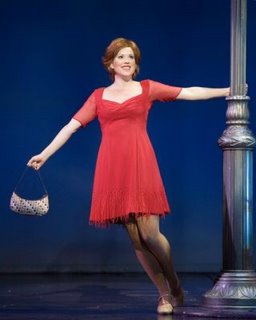 According to comments in the pre-show talk, by Kyle Haden, Velina Hasu Houston is the country’s most prolific playwright. Since 2000, she has had world premieres of six different plays and will premiere four new plays in 2006 and 2007.
According to comments in the pre-show talk, by Kyle Haden, Velina Hasu Houston is the country’s most prolific playwright. Since 2000, she has had world premieres of six different plays and will premiere four new plays in 2006 and 2007.One of her newest works, “The Peculiar and Sudden Nearness of the Moon,” directed by Peggy Shannon, opened this week at the Sacramento Theater company, where it will run through December 24. While it is out of the workshop stage, the cast is still in the process of tweaking it and a final script won’t be printed until this run ends.
Many of the multi-racial playwright’s works deal with various aspects of race and “Moon” takes it in an unusual direction.
Sydney Spencer (Saffron Henke) and her husband Brad (Brett Williams) are an upper middle class couple who have planned the perfect life. They have the perfect home, the perfect jobs, and are expecting the perfect baby.
As her pregnancy progresses, Sydney is visited by “The Dark,” (Kyle Haden) a ghost-like figure, speaking all in rhyme, who describes himself as a “fugitive from history” and warns of dark secrets about to be uncovered.
When the baby is born, she isn’t at all what Sydney and Brad expected. Her skin is dark, her hair is black and curly and, not surprisingly, the very Nordic, blonde Brad assumes Sydney has been having an affair.
The baby, who was born prematurely, has some minor health problems and most of the first act takes place in the neonatal intensive care unit, with the baby’s incubator dominating the stage.
As the play progresses Sydney begins to explore some of the deepest meanings of life as she deals with questions of identity and “belonging” in the context of race, culture and class.
Sydney turns to her mother Jessica (Susan Andrews) for answers about her own lineage, but the mother refuses to discuss her heritage, so Sydney is on her own, following clues that lead her to an enigmatic man named Sydney (Vincent Dee Miles), who directs the woman’s questions to a woman named Grace-Maria Marquez (Irene Velasquez).
There is a great difference in “feel” between Act 1 and Act 2. Act 1 has a more spiritual, ethereal aspect to it while Act 2 seems to center more on who knew what when and who is willing to be open and honest, and how everyone reacts to the truths that begin to come spilling out.
The show ends with a “Guess Who’s Coming to Dinner” situation and though questions are answered, the audience is left hanging as to the outcome for the new baby and her family.
Director Shannon has assembled a strong cast. Henke nicely handles the fear for the safety of her unborn child when “Dark” begins to confront her, the confusion about the baby’s appearance, and the growing love she feels for her child.
Sydney’s husband perhaps goes through the greatest character shifts, from supportive husband, to angry cuckold, to a father who begins to recognize his own child, and Williams makes the character a sympathetic one.
Andrews handles the brittle Jessica adroitly. Haden is outstanding as the enigmatic “Dark.”
While the play addresses very real, valid emotions, the work as a whole doesn’t quite come together coherently. Given experience with Houston’s work in the past, I am certain that as the cast, director and playwright respond to audience reaction, the final product will be a valuable addition to Houston’s total body of work.


